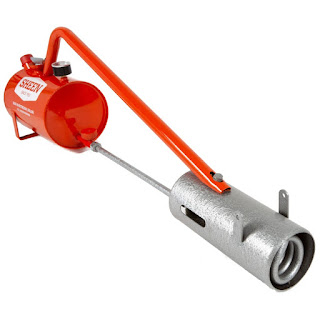Sheen X300 Flame Gun
Weed control with the SHEEN X300 ORGANIC PARAFFIN WEED FLAME GUN....
For the safe and organic control of weeds look no further than the Sheen X300.
Running on economical and affordable paraffin fuel this large sized "weed-wand" makes light work of overgrown and unwanted plants in the garden, on the allotment, or any other area where weeds are present.
We believe this particular weed flame gun is the best you can buy in the current range that is freely available in the UK, manufactured here in England in the UK the Sheen weed flame gun is not only very effective but robust as well.
This "top selling" gardening tool works by searing organic weed material with a high temperature heat blast at around 2000 degrees Fahrenheit, when this is aimed at the base of any weeds it stops the plants sap rising.
All the user has to do is then leave the weeds to dry out for a few days before giving them a second "heat blast". This second application of heat then incinerates all top growth of the weed(s) reducing them to a rich potash residue.
Sheen X-300 Features
- One gallon capacity fuel tank (paraffin)
- Integral pressure pump and gauge
- Precision control valve and burner unit
- Supplied with a nozzle "pricker" to maintain clean burning
- Weight (dry) without fuel: 5kg
- Overall length is 950mm (without burner hood)
- Other accessories available to buy (hood and trolley)
- The packaging box size is approximately 690mm x 350mm x 240mm
- Runs on paraffin
- Made in England
- A non-toxic way to kill weeds and pests in your garden
Typical applications:
As well as slugs, weeds are one of the biggest problems faced by gardeners and landscapers. The organic control of weeds means control and eradication without resorting to common chemical weed killers. Organic methods include manual removal, smothering, using barrier methods, and by use of the handy tool here - weed burning by use of a Sheen Flamegun.
Deep routed and persistent weeds can be very difficult to remove if you are counting on manually weeding them, you can save hours of time as well as hard work by way of using a flame gun instead.
Weeds can be found in a wide range of areas in the garden as well as the allotment, in addition they can be found in veg patches, on driveways and paths, along the walls of the house or outbuildings, between block paving bricks, on boundary walls and fences, next to garages and conservatories, and many more places.
A really common place is in between paving slabs and patio stones, here they can really look unsightly if left to expand and develop.
As far as running times go this weed-killer gun can run for approximately 45 minutes when on it's full setting making it perfect for use not only in domestic gardens but on allotments and commercial property sites too.
Sheen X300 Weed Burner Instructions
Where can i find a copy of the instructions / operator guide for this paraffin weed wand / burner?
Our website features a link to the UK manufacturers website where you can download a free copy of the Sheen X300 instructions. It can be viewed here.
Where To Buy From In The UK
This kerosene / paraffin weed burner can be purchased in the UK from several suppliers.
There are a few stockists that keep this unit on the shelf for collection from their shops but most people choose to order and buy it online.

